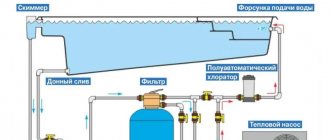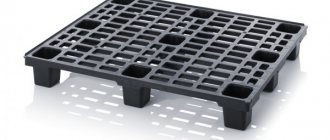What is geogrid
The very name of the material contains the term - lattice. But it is necessary to understand that the geogrid itself is three-dimensional, that is, volumetric. In this case, the material is assembled from strips connected to each other by welding or soldering. Because of this, the structure of the geogrid turns out to be cellular, in which the cells are arranged in a checkerboard pattern. It is in this way that the rigidity of the structure and the strength of the coating, in which the geogrid is used, are achieved.
The purpose of this volumetric cellular material is to keep the soil, which is subjected to heavy loads, from “creeping”. Therefore, this material is mainly used in road construction, laid under the road surface. And also for strengthening slopes and slopes.
In road construction, before the advent of geogrids, metal meshes were used, woven like a chain-link mesh. As well as concrete cellular products, which were laid next to each other. The photo below shows this type of strengthening of paths.
Concrete elements for strengthening roads Source pinterest.com
All this was not cheap, and besides, the metal quickly failed under the influence of natural loads, because it twitched in the corrosion ground. Concrete served for a long time, but concrete products are very expensive. And it’s more difficult to work with them. And when geomaterials appeared on the market, they quickly replaced both metal and concrete products.
Material for geogrids
Today, manufacturers offer several types of geogrids for garden paths, made from different materials.
- Polymer volumetric geogrids . They are mainly made from polystyrene. Essentially, these are tapes that are fastened together by welding or ultrasonic soldering. On the market, such geogrids are presented in two variations: solid or perforated. The first is used if the filler is a fine-grained material, for example, sand. The second is used if the filler has a coarse-grained structure, for example, crushed stone or gravel. The height of the tapes used varies from 50 to 300 mm; it is this parameter that creates the volume of the structure.
Polymer volumetric geogrid Source geo-sm.ru
- Polymer flat geogrids . This is a roll-type material, which is not a lattice, but a mesh, although it belongs to the category of “geogrids”. Its height is the thickness of the polymer rod from which the mesh is made. Manufacturers offer two types of mesh: single- or biaxial. The first one works only on tension in one direction - longitudinal. Therefore, its design contains rectangular cells, that is, elongated along the roll. This mesh is mainly used to strengthen slopes. The second is a lattice with square cells that can withstand loads in both the transverse and longitudinal directions. Hence its high versatility. The polymer mesh is made from polyester or polypropylene.
Polymer flat geogrids Source rollgeo.ru
- Geogrids made of geotextile fabric . That is, for the manufacture of geogrids, strips of needle-punched or woven geotextiles are used. In this case, high-density material is used. This is the cheapest geogrid, but with not the highest performance characteristics. And although such a geogrid can withstand tensile loads well, it has a low compressive strength, especially transverse. Therefore, this type is more often used as a demarcation layer between different layers of building materials being laid.
Geogrid made of geotextile fabric Source yandex.kg
- Plastic . They are made mainly from polyethylene, both low and high pressure. They are mainly used in dachas when it is necessary to build paths, platforms or parking areas. Firstly, these are rigid structures with certain dimensions in area. Secondly, the panel assembly simplifies the installation process. Thirdly, the rectangular shape is easily formed by the area of the platforms and paths, without significant changes to the lattice itself.
Modular geogrids made of plastic Source covermart.ru
Features of the technology
As the name suggests, a volumetric geogrid consists of cells that are formed by intersecting or interconnected strips. This allows you to form a stable frame that secures the soil and prevents it from subsiding. The grating makes the surface more resistant to loads in both horizontal and vertical planes.
Road surface design without geogrid / Road surface design using geogrid
Due to the fact that it is made from environmentally friendly materials (polyethylene), it does not have a negative impact on the environment.
Rules for using geogrids for paths
Since this material is presented in models of different designs, the method of its installation will vary. First of all, markings are made for the paths, after which the turf and root system are removed. Next, level the base and compact it.
If a polymer product assembled from tapes is used as a geogrid, then geotextiles will have to be laid under it. The remaining operations are carried out in the following order:
- , L-shaped pins are driven into the ground to a shallow depth (not completely) . They are usually made from thick wire or thin steel reinforcement. The distance between the pins determines the size of the cells of the selected lattice material. For example, if the cell dimensions are 210x210 mm, then the pin installation step should be 210 mm; if the cell size is 400x400, then the pins must be driven into the ground every 400 mm.
Fastening the geogrid with reinforcing pins Source pezuc.konysu.ru.net
See also: Catalog of projects of two-story wooden houses from manufacturers.
- The geogrid is laid out so that the pins driven into the ground fall into the middle of the tape forming the cells. After which the pins are driven in until they stop.
- They stretch the geogrid to the opposite edge of the path and immediately fasten it to the ground with pins, hammering it in order into each cell. Since garden paths are small in width, this number of fasteners will be sufficient. If a platform or parking lot for cars is being built, then the geogrid will have to be nailed not only along the edges, but also every 0.5-1.0 m. In this case, the fasteners must be placed in a checkerboard pattern.
- If one roll is not enough, then lay a second one . The edges of the two elements are connected to each other with knitting wire or plastic clamps.
When the lattice base for the path is ready, it can be filled. If it is concrete mortar or crushed stone, then the cells are filled with it to the upper edges. If sand or soil is placed, then the backfill is overfilled within 25-50 mm, because any bulk material shrinks over time.
Additional recommendations
To increase the efficiency of geogrid use, experts in the field of road construction recommend the additional use of geotextiles: it serves as a separation and drainage layer between the soil base and the geogrid. Geotextiles easily allow moisture to pass through, but retain soil particles. This prevents the layers of road pavement from mixing, which prevents deformation of the road surface - its subsidence, dips, and the formation of cracks.
The road base resulting from such sequential laying forms a monolithic structure. The strength of the road surface increases several times, and its service life increases to several decades.
Video description
The video shows how to lay a volumetric geogrid and fill it with crushed stone screenings to form the entrance to a summer cottage:
Experts draw attention to the fact that craftsmen often make a big mistake by dropping the filler from a great height. This damages the grating material. The optimal discharge height is within 0.6-1.0 m. If the cells are small, then 60 cm is the ideal parameter. If the grid cells are large, then it can be increased to the maximum.
The easiest way to install geogrids is for paths made of hard plastic. These are panels of certain sizes that are laid close to each other and secured with the same pins. There is no need to stretch or adjust anything. If the outer row of the geogrid does not fit within the boundaries of the garden path, then the panels can be easily cut to the required size using a hacksaw or a grinder with a cutting disc.
How to lay a geogrid made of durable plastic in rows Source optimapol.ru
How to strengthen slopes yourself?
The use of a geogrid allows you to level out differences in the landscape in your dacha and garden areas. A large number of advantages and resistance to mechanical deformation make this type of material the best fixation for creeping soil.
To carry out installation work to strengthen the slope, it is recommended to follow the laying technology. In this way, it is possible to increase the efficiency of the polymer web.
Installation consists of several points:
- Preliminary preparation of the slope is carried out. Here it is necessary to clear the area of large stones, the size of which is more than 10 centimeters. In addition, it is necessary to get rid of roots and woody growth. Deep uneven areas are covered with earth;
- Next, proceed to the installation of the fastening. To do this, guide rails are installed. Before fixing the geogrid, you must ensure that its base is 35-40 cm smaller than the size of the area. To fasten the geogrid, anchors made of dense polymer plastic are used. If there is a large slope in the area, dowels are used to hold it in place. They are shaped like the letter L;
- The final step will be filling the geogrid with soil mixture. Peat, river sand and chernozem are used for this.
During the installation process, it is necessary to take into account the presence of special trays that will be used to remove excess moisture.
Price of offered products
Today, buying a geogrid for paths in your country house is not a problem. They are present on the shelves of construction stores and markets. They are sold today even in online stores. It is clear that prices vary greatly according to the material from which they are made, and by size (height and width of cells), and by region.
Let's outline some prices for geogrids for garden paths.
- lattice height 50 mm , cell dimensions – 210x210 mm, price: 70 rubles per 1 m² of canvas;
- height 70 mm , cell dimensions 320x320, price – 50 rub./m²;
- height 100 , cell parameters 160x160 mm, cost 180 rubles per square meter;
- height 200 , cells 210x210, product price 255 rub./m².
That is, it turns out that the smaller the cell sizes, which means the denser the material itself, plus the greater the height of the lattice, the higher the price of the building material. But since garden paths in the country are practically not subject to serious loads, it is recommended to purchase not the most expensive option for their installation. And this could be a geogrid 50 mm high with cell sizes 210x210 mm. If you need to strengthen the area for parking a car, then it is better to use material with dimensions: height 70-100 mm, cell parameters from 160 to 400 mm.
The smaller the cell sizes, the more expensive the lattice price Source studall.org
Preservation of the grass surface
Although most private houses have garages, it is quite difficult to park your car in a suburban area. There are practically no special parking lots, and leaving vehicles on the street, under a fence, is not always possible. Everyone knows how narrow the streets and alleys in our garden communities are, so often you can simply “block” the passage with your car.
Driving them onto the site means ruining the grass cover. You can, of course, concrete the area, but given the modest size of most garden plots, is it worth doing?
About cells and material
So, today geogrids are produced with certain parameters. This height ranges from 5-20 cm, cell sizes from 16x16 to 40x40 cm. The tapes themselves from which the gratings are assembled can be perforated, solid or combined. But in any case, the surface of the tapes is a textured plane. Let us add that the perforated surface simply improves soil drainage; it has no other purpose.
As for the texture of the tapes, its purpose is to increase the bonding of the geogrid with the filler. And this, in turn, increases the strength of the material itself due to the frictional force that arises between the lattice and the filler when some kind of load presses on the former. In this case, the friction force does not decrease with decreasing filler grain size.
Perforated geogrid is a well-organized transverse drainage Source meaplast.ru
It should be noted that experts recommend using perforated geogrids even for the construction of garden paths. Because they have quite serious strength characteristics due to the fact that:
- frictional interaction appears between the lattice walls and filler grains;
- due to filling the walls of the belts with granules;
- plant roots pass through the holes unhindered , thereby holding the lattice together;
- under the influence of heavy concrete, the tapes bend , creating complex shapes, thereby forming complex modular structures with higher strength characteristics.
Let us add that the perforated version is cheaper than the solid one, because it uses less raw material. As mentioned above, water passes through perforated tapes without hindrance. That is, a transverse drainage system is organized.
In difficult geological conditions
The design features of geogrids, in particular the cellular structure, as well as high strength and durability indicators make such products the optimal choice for road construction in difficult geological conditions.
As practice shows, on loosely cohesive, clayey, weak soils, strengthening with geogrids makes it possible to significantly increase the strength and durability of the roadway. The use of this material for reinforcing road pavements is also relevant in regions where sharp fluctuations in air temperatures are observed. Geogrid helps to reliably strengthen the soil in places with high humidity and high levels of precipitation.











